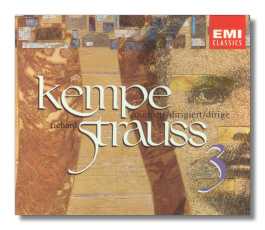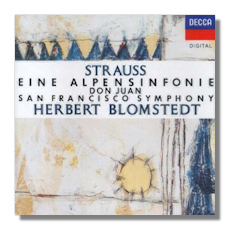
The Internet's Premier Classical Music Source
Related Links
-
Find CDs & Downloads
Amazon - UK - Germany - Canada - France - Japan
ArkivMusic - CD Universe
Find DVDs & Blu-ray
Amazon - UK - Germany - Canada - France - Japan
ArkivMusic-Video Universe
Find Scores & Sheet Music
Sheet Music Plus -
Search Amazon
Recommended Links
Site News
Richard Strauss
Annotated Discography
Eine Alpensinfonie, Op. 64
EMI CDC754610-2
Richard Strauss/Bavarian State Orchestra (1941)
At slightly under 46 minutes, this clocks in as one of the fastest Alpine Symphonies ever: most hover around 50 minutes. Strauss makes up most of the speed by refusing to linger over the slow sections. Those who dislike bad sound in their Strauss – the transfer has been made at a very low volume and has a constant hiss that sounds like steam escaping – had best avoid this disc. The Bavarian State Symphony wins no awards for precision either. The famous 12 off-stage horns, the beautifully-layered textures simply sink beneath a boggy sound. Most of the contrapuntally complex passages like "Ascent," "Pasture," "Through Thicket and Undergrowth," "Vision," and "Storm," churn away to mush. Nevertheless, in many ways, this performance reveals to the listener a greater substance to the piece than commentators usually credit, for them a prime exhibit in the case for Strauss as Mere Realist. They view it as a travelogue up and down a mountain. You might as well say that Frost's "Birches" talks only about trees.
Still, the work owes its inspiration in part to the death of Mahler, whom Strauss admired as a conductor and disparaged as an "amateurish" composer – a not uncommon view of Mahler at the time. Striking similarities to Mahlerian ideas and moods – the Sixth, Seventh, and particularly the Fourth symphonies – appear throughout the work. I also find much of the spirit of the Beethoven Sixth and of Wagner's "Forest Murmurs." Norman Del Mar ascribes this eclecticism to Strauss' conducting career. For him, it intrudes. I note the borrowings but feel that Strauss has essentially performed an homage and transformed his allusions to his own purposes.
Strauss the conductor, given the quality of his forces, of necessity emphasizes the larger structural coherence of the piece, as well as its singing qualities, most apparent in the long conclusion to the work. He can't fall back on the gorgeous sound or the orchestral wizardry and, oddly enough, reveals much of the work's musical stature.
EMI CMS764350-2
Rudolf Kempe/Staatskapelle Dresden (1973)
The Dresdener string tone hasn't the weight of the Berlin, but Kempe makes up for that with an aggressive attention to detail. The textures, so bright and in-your-face, sometimes create the illusion of hearing individual players, usually in the winds. Given his wonderful performance of Zarathustra, I expected great things from Kempe, but he disappointed me. Unlike the mostly laid-back Karajan, Kempe keeps everything on the move, almost as if afraid that pausing would spell the work's disintegration. Consequently, everything comes at you on the same level of presentation, and you lose sense of the work's structural profile. Even the dynamic range seems shortened from moderately loud to strident. Almost predictably, Kempe does better with the exciting sections (the storm succeeds in spades) and marks time with the meditational ones – e.g., "Pasture," "Vision," "Elegy," and the conclusion. Still, no one beats Kempe at showing how Strauss built his tonal masses.
Deutsche Grammophon 439017-2 or 400039-2
Herbert von Karajan/Berlin Philharmonic (1981)
As Karajan begins, you may think this the greatest performance of the work you've ever heard. And so it is, from moody, moving introduction through the "Sunrise." It then settles into Karajan's usual suave treatment of Strauss. The Berlin Philharmonic sounds big and glossy, the strings almost too full, the textures superbly balanced.
It reminds me of riding in a Cadillac: everything is smoothed out and secure, and nothing is really interesting. We hear the sections magnificently played, but to little purpose, super-produced and glitzy. The "Storm" shows well the limitations of Karajan's approach. This is probably one of the most orchestrally inventive and musically least interesting sections of the symphony, but, then, the storm in Beethoven's Sixth affects me the same way. The only two storm depictions that strike me as real music are in Wagner's Fliegende Holländer and Britten's Peter Grimes. Karajan brings out each rumble and crash, his approach so literal and pictorial that you almost see the raindrops. Yet the section fails to cohere musically, until Karajan can fasten on the "Pasture" motive's return as a gravitational center. Once the swirl begins to organize itself about that theme, Karajan brings off a creditable conclusion. A superbly well-played Alpine, but, really, a bit soul-less.
London 421815-2
Herbert Blomstedt/San Francisco Symphony (1988)
Not only the clear winner among recorded performances of this particular work, Blomstedt's interpretation counts as one of the finest Strauss recordings ever. Blomstedt and the San Francisco bring to the work the basic elements of successful Strauss playing: gorgeous sound, clear textures, and sheer physical excitement. Yet this is not the standard tour of Strauss. Blomstedt provides both a certain restraint in most of the obvious climaxes and an intensity in the meditative passages. Further, Blomstedt manages to make you hear Strauss' perhaps too-familiar harmonies as new and ear-stretching. He sees, like few conductors, the link Strauss had in mind to Zarathustra. The symphony does not merely depict "a day in the life of a mountain," as many would have it. I, for one, find it difficult to accept that Strauss worked for three years, hard, to produce a triviality and believe the composer intended it as a spiritual testament, hinted at very strongly by his notion at one time of calling it the Antichrist (from Nietzsche). A conductor must go beyond the undeniably spectacular effects in the score, and Blomstedt does so time after time. He doesn't slight the pictorial, in sections like "Waterfall" and "Apparition," and he also brings to the fore the meditations in the work – "Vision," "Elegy," and "Ausklang." Furthermore, he shows the double nature of even the pictorial passages. Thus, guided by Blomstedt, we see that the "Calm before the Storm" really extends the preceding "Elegy" – indeed, it disintegrates into grief and into the anger of the storm; the "Ausklang" becomes the reconciliation to loss. Unlike both Karajan and Kempe, Blomstedt actually finds the musical center of the "Storm," as well as the effects, by elevating what the others view as a subsidiary line.
The recorded sound is, of course, "better than real life," but it doesn't intrude. Like the interpretation itself, it focuses on the music rather than the sound.
Copyright © 1994-2008 by Steve Schwartz & Classical Net. All Rights Reserved.

















